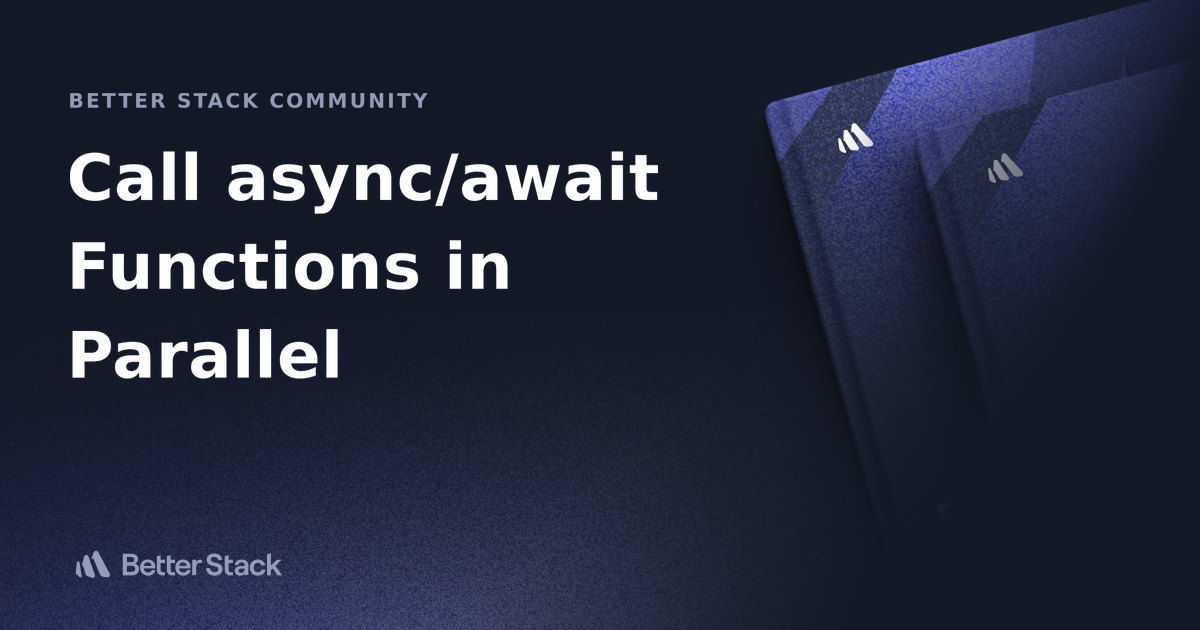Run Async/Await Functions Concurrently
Learn how to optimize your code's efficiency by executing multiple asynchronous operations concurrently using the power of async/await in JavaScript.
Learn how to optimize your code's efficiency by executing multiple asynchronous operations concurrently using the power of async/await in JavaScript.
This article provides a step-by-step guide on how to run asynchronous functions concurrently in JavaScript using the async/await syntax. While async/await simplifies asynchronous operations, it doesn't inherently execute them in parallel. The guide will cover two primary methods for achieving parallelism: using Promise.all and utilizing independent await blocks within an async function. Each method will be explained with code examples and instructions. Additionally, the guide will address error handling considerations and provide guidance on choosing the appropriate method based on the complexity of your use case. By following these steps, you'll learn how to effectively leverage the power of async/await for parallel execution in your JavaScript applications.
While async/await simplifies handling asynchronous operations, it doesn't inherently execute them in parallel. Here's how to achieve parallelism with JavaScript:
Step 1: Define Your Async Functions
Start by creating the asynchronous functions you want to run concurrently. These functions should use the async keyword and typically involve operations like fetching data or performing time-consuming tasks.
async function fetchData(url) {
const response = await fetch(url);
const data = await response.json();
return data;
}
async function processData(data) {
// Perform some processing on the data
return processedData;
}Step 2: Initiate Parallel Execution
There are two primary methods to run these functions in parallel:
Method 1: Using Promise.all
await: This initiates their execution without blocking the main thread. Store the returned promises in an array.const promise1 = fetchData('https://api.example.com/data1');
const promise2 = fetchData('https://api.example.com/data2');Promise.all to await all promises: This waits for all promises to resolve and returns an array of their results.const results = await Promise.all([promise1, promise2]);
const data1 = results[0];
const data2 = results[1];Method 2: Using async/await with Independent Blocks
async function runParallel() {
// ...
}await calls: Each await within its own block will run concurrently.async function runParallel() {
const data1Promise = fetchData('https://api.example.com/data1');
const data2Promise = fetchData('https://api.example.com/data2');
const data1 = await data1Promise;
const data2 = await data2Promise;
// ... further processing with data1 and data2
}Step 3: Process Results
Once you have the results from both functions, you can proceed with further processing or utilize the data as needed.
Example: Combining Both Methods
async function runParallel() {
const [data1, data2] = await Promise.all([
fetchData('https://api.example.com/data1'),
fetchData('https://api.example.com/data2')
]);
const processedData1 = await processData(data1);
const processedData2 = await processData(data2);
// ... use processedData1 and processedData2
}Key Points:
try/catch blocks within your async functions or when using Promise.all.Promise.all is concise for simple parallel execution. Independent await blocks offer more flexibility for complex scenarios with additional logic between awaits.By following these steps and understanding the methods, you can effectively leverage the power of async/await for parallel execution in your JavaScript applications.
This JavaScript code demonstrates two ways to run asynchronous functions concurrently: using Promise.all and independent await blocks. The fetchData function retrieves data from a specified URL and parses it as JSON. The processData function simulates data processing by waiting for 1 second and then doubling each element in the input array. The runParallel function showcases both methods: Promise.all fetches data from two URLs simultaneously, while independent await blocks process the fetched data concurrently. The code measures and logs the total execution time, demonstrating the efficiency of parallel execution.
This example demonstrates both methods described in the article: using Promise.all and independent await blocks for parallel execution.
async function fetchData(url) {
const response = await fetch(url);
const data = await response.json();
return data;
}
async function processData(data) {
// Simulate processing time
await new Promise(resolve => setTimeout(resolve, 1000));
return data.map(item => item * 2); // Example processing
}
async function runParallel() {
console.time('Parallel Execution');
// Method 1: Promise.all
const [data1, data2] = await Promise.all([
fetchData('https://api.example.com/data1'),
fetchData('https://api.example.com/data2')
]);
// Method 2: Independent await blocks
const processedData1Promise = processData(data1);
const processedData2Promise = processData(data2);
const processedData1 = await processedData1Promise;
const processedData2 = await processedData2Promise;
console.log('Processed Data 1:', processedData1);
console.log('Processed Data 2:', processedData2);
console.timeEnd('Parallel Execution');
}
runParallel();Explanation:
fetchData Function: Fetches data from a URL and parses it as JSON.processData Function: Simulates processing by waiting for 1 second and then doubling each element in the data array.runParallel Function:
Promise.all to fetch data from two URLs concurrently and store the results in data1 and data2.data1 and data2 concurrently using independent await blocks.Running the Example:
parallel.js).node parallel.js
You should observe that the processing of data1 and data2 happens concurrently, and the total execution time is roughly equivalent to the processing time of a single data set (around 1 second).
Beyond the Basics:
async/await is also valuable for concurrency (managing multiple tasks that may not necessarily run at the same time).Task.all offers a more structured approach to parallel execution compared to Promise.all. It provides better error handling and cancellation capabilities.Advanced Techniques:
Error Handling in Depth:
Promise.all, a single error will reject the entire promise. Use try/catch blocks within each async function or consider using libraries like p-all that provide more granular error handling.await call can have its own try/catch block, allowing for more specific error handling.Choosing the Right Method:
Promise.all is often the most straightforward choice.await blocks provide more flexibility for interleaving logic and error handling.Task.all offers advantages in terms of structure and error handling.Real-World Applications:
Remember: Parallel execution can significantly enhance the performance and responsiveness of your JavaScript applications. By understanding the techniques and considerations outlined in this guide, you can effectively leverage async/await to achieve parallelism and build more efficient and scalable applications.
| Step | Description | Methods |
|---|---|---|
| 1. Define Async Functions | Create functions using async keyword for tasks like data fetching. |
Example: async function fetchData(url) {...}
|
| 2. Initiate Parallel Execution | Run functions concurrently without blocking the main thread. |
Method 1: Use Promise.all to wait for all promises to resolve. Method 2: Use independent await calls within an async function. |
| 3. Process Results | Handle data returned from async functions. | Example: Further processing, data utilization. |
In conclusion, mastering the art of running async/await functions in parallel empowers JavaScript developers to create highly performant and responsive applications. By understanding the core methods – Promise.all for concise parallel execution and independent await blocks for more intricate workflows – you can effectively tackle scenarios involving data fetching, image processing, batch operations, and more. Remember to consider error handling mechanisms and choose the most suitable approach based on your specific use case. As you delve deeper, explore advanced techniques like Promise.race, async generators, and third-party libraries to further enhance your asynchronous programming skills. With these tools and knowledge at your disposal, you'll be well-equipped to unlock the full potential of async/await and build efficient, scalable JavaScript applications that deliver exceptional user experiences.
 How to call async/await functions in parallel - DEV Community | Consider the following code: const p1 = () => new Promise((resolve, reject) => { ...
How to call async/await functions in parallel - DEV Community | Consider the following code: const p1 = () => new Promise((resolve, reject) => { ... What is the idiomatic way to running two async methods in parallel ... | I have two situations that I’m not quite sure how to best write using the new Swift concurrency features. It’s in a Vapor code base, but this isn’t really tied to Vapor. I’m not quite sure whether a TaskGroup is the right thing to do or async let. Or is there some other way that I’m missing here? What is the best and/or idiomatic way to do this? The two situations are: 1. An async method that kicks off two other async calls and then returns when both are done Here’s what I came up with for t...
What is the idiomatic way to running two async methods in parallel ... | I have two situations that I’m not quite sure how to best write using the new Swift concurrency features. It’s in a Vapor code base, but this isn’t really tied to Vapor. I’m not quite sure whether a TaskGroup is the right thing to do or async let. Or is there some other way that I’m missing here? What is the best and/or idiomatic way to do this? The two situations are: 1. An async method that kicks off two other async calls and then returns when both are done Here’s what I came up with for t... Concurrency | Documentation | Perform asynchronous operations.
Concurrency | Documentation | Perform asynchronous operations. Call Multiple async/await Functions Parallel or Sequential - Ankur ... | In some situations, for code execution speed performance, it is good to call async/await functions parallel or sequential for code optimization.
Call Multiple async/await Functions Parallel or Sequential - Ankur ... | In some situations, for code execution speed performance, it is good to call async/await functions parallel or sequential for code optimization. Call async/await Functions in Parallel | Better Stack Community | Better Stack lets you see inside any stack, debug any issue, and resolve any incident.
Call async/await Functions in Parallel | Better Stack Community | Better Stack lets you see inside any stack, debug any issue, and resolve any incident. How to call async/await functions concurrently in Swift | Tasks are a new feature in Swift introduced during the WWDC21 that work hand in hand with the new async/await functionality. Each task runs concurrently, so tasks allow us to call asynchronous functions in parallel.
How to call async/await functions concurrently in Swift | Tasks are a new feature in Swift introduced during the WWDC21 that work hand in hand with the new async/await functionality. Each task runs concurrently, so tasks allow us to call asynchronous functions in parallel.